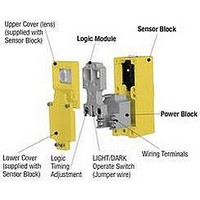LM3 BANNER ENGINEERING, LM3 Datasheet - Page 14

LM3
Manufacturer Part Number
LM3
Description
Photoelectric Sensor
Manufacturer
BANNER ENGINEERING
Datasheet
1.LM1.pdf
(32 pages)
Specifications of LM3
Timing Function
On-Delay And Off-Delay
Time Range
None To Output Follows Input
Application
Interconnecting the power block and scanner block
Brand/series
Multi-Beam®
Function
Module, Logic
Includes
Blade & socket connector
Logic Type
ON⁄OFF, Light or Dark Operate
Sensing Mode
Adjustable Field
Technology
Photoelectric
Accessory Type
Logic Module
Lead Free Status / Rohs Status
RoHS Exempt Product
For Use With
Multi-Beam Sensors
Available stocks
Company
Part Number
Manufacturer
Quantity
Price
Part Number:
LM30-00J051203E
Manufacturer:
MONRSUN
Quantity:
20 000
Part Number:
LM3000ASQ/NOPB
Manufacturer:
NS/国半
Quantity:
20 000
Company:
Part Number:
LM3000SQ/NOPB
Manufacturer:
National Semiconductor
Quantity:
1 820
Company:
Part Number:
LM300Q5
Manufacturer:
SAMSUNG
Quantity:
1 000
Company:
Part Number:
LM300W01-A1
Manufacturer:
SAMSUNG
Quantity:
1 000
Company:
Part Number:
LM300W01-STA1
Manufacturer:
SAMSUNG
Quantity:
1 000
Company:
Part Number:
LM300W01-STA4 L
Manufacturer:
SAMSUNG
Quantity:
1 000
14
MULTI-BEAM
For information on the complete
selection of individual glass fiber
optics, see Banner product catalog.
NOTE:
ceivers do not have the Alignment Indicating
Device (AID™) signal strength feature. The
alignment indicator is "ON" steadily when
enough light is sensed.
MULTI-BEAM 3- and 4-wire Scanner Block Modifications
HIGH SPEED MODIFICATION "MHS": scanner blocks with 1 millisec-
ond response may be modified for 300 microsecond (0.3 millisecond) response.
This modification is designated by adding suffix "MHS" to the scanner block
model number (e.g.- SBF1MHS, etc.). High speed is most often required in
fiberoptic or opposed mode sensing. The MHS modification reduces the
available excess gain by about 50%, and also decreases the sensor's immunity
to some forms of electrical "noise".
FIBER OPTIC AMBIENT
The following are popular modifications to MULTI-BEAM 3- & 4-wire scanner blocks. They are not stocked, but are available on a quote basis.
LIGHT RECEIVER
AMBIENT LIGHT
(glass fiber optics)
Sensing Mode
MULTI-BEAM ambient light re-
RECEIVER
SBAR1
Response: 10ms on/off
Amplifier: normal gain
Optical response: ultra-
violet through near infrared
(includes all visible
wavelengths)
SBAR1GH
Response: 10ms on/off
Amplifier: high gain
Optical response: ultra-
violet through near infrared
(includes all visible
wavelengths)
These scanner blocks are non-modulated receivers which are operated by sunlight or incandescent, fluorescent,
infrared, or laser sources. A typical application would involve mounting the scanner block underneath a roller
conveyor, "looking" up between the rollers at the overhead factory lighting. Any objects passing over the sensor
would then cast a shadow, resulting in an output (dark operate). Ambient receivers are used with LM5-14 delay
logic to sense daylight for outdoor lighting control. These sensors can also sense the large amounts of infrared light
(heat energy) which is emitted by hot or molten glass, metal, or plastic during processing of these materials.
Model SBAR1 is for general application. Model SBAR1GH is a high gain version. It is about twenty times more
sensitive to light as compared to the SBAR1. The range at which either model will sense a light source depends
upon both the intensity of the light source and the contrast in intensity between the source and the rest of the ambient
light in the viewing area.
NOTE: ambient receiver scanner blocks will also work with 2-wire power blocks and logic. However, the light/
dark operate functions will be reversed when using 2-wire components.
SBAR1GHF
Response: 10ms on/off
Amplifier: high gain
Optical response: wave-
lengths from visible blue
through near infrared
Model SBAR1GHF is identical to model SBAR1GH (above) except that it is equipped with an upper cover
assembly (model UC-RF) which allows an individual glass fiber optic assembly to be attached to the receiver
optoelement. This model is used for ambient light detection in locations which are either too confined or too hot
for mounting of the complete scanner block. A typical application involves sensing product presence or counting
during processing of red-hot or molten glass or metal. The addition of an L9, L16F, L16FAL, or L16FSS lens to
a threaded fiber assembly (e.g. IT23S) can narrow the angle of light acceptance to less than the angle of the SBAR1
lens. The high gain amplifier of model SBAR1GHF helps to offset light losses which are experienced with
fiberoptic light pipes. NOTE: glass fibers will not efficiently pass ultraviolet wavelengths.
3- & 4-wire Scanner Blocks
Models
Functional Schematic
Direct Sensing of Radiant Infrared Energy
ZERO HYSTERESIS MODIFICATION "MZ": amplifier hysteresis may
be removed from 3- and 4-wire scanner blocks when attempting to sense very
small signal changes (contrasts less than 3). This modification is designated by
adding suffix "MZ" (Modified Zero Hysteresis). Be sure that all variables
affecting the sensor's optical response remain constant before ordering the zero
hysteresis modification .















